First impressions of the Pardini K22 free pistol
Posted: Wed Mar 01, 2006 5:40 am
I'm pretty new to free pistol, having just started shooting at my club's weekly informal matches about a month ago. Being very informal, they let me shoot my Pardini SP with a red dot to get started, but pretty quickly I decided a wanted a genuine free pistol. Monday, I finally got a Pardini K22 and, that evening, got my first chance to try it out. I'm already delighted with my choice and, in this post, I'll try to tell you more about the gun, hopingfully making up somewhat for the lack of information -- and especially, the lack of any clear pictures -- to be found elsewhere on the web. But first, let me explain how I chose the Pardini.
My decision process
It's pretty easy to discover that the two guns most people focus on are the Toz 35 and the Morini 84E, so understandably, these were guns I knew I should consider right from the start. Not many people seemed to like the Pardini. One person told me I'd be "wasting my money" and that it'd have terrible resale value. Here on TT, someone else labeled it "odd-functioning" and "odd-looking." But it didn't appear that anyone making these remarks had actually fired or even handled a K22 and I tend to be pretty independent-minded anyway. Though I don't actually expect resale would be a problem, I decided it wasn't that important to me (I buy guns and I shoot them but I don't sell them :) And oddity, like beauty, is in the eye of the beholder: To me, the K22 certainly didn't look as strange as, say, the Hammerli with "rabbit ears." But mostly, I decided to consider the Pardini K22 because of previous experience with Pardini: I've had two other Pardinis (an SP and an HP) for about 5 years that I've loved and never for a moment regretted buying.
At the club, I was able to try out a couple Toz 35s that belonged to other members. They seemed to point well but I found the triggers too crisp for my taste, especially at the tiny trigger pull weights typical of a free pistol. I like a gun with some tiny amount of takeup so I can safely find the trigger with my finger without accidentally firing the gun. For me, the Toz was hard to control precisely because I wasn't able to do that. Also, I honestly just didn't like the cosmetics of the Toz. What can I say? It's Russian, with all the fit and finish of a lawn mower. For example, though they appeared to work fine, the sights on the one of Tozs were visibly crooked. The other one had come that way, too, apparently, but that the owner told me he had ground it down to get it straight because it had annoyed him, also. Realistically, I'm only an "okay" shooter, hence my adage that if you can't hit the target, at least have a pretty gun. The Toz just wasn't what I wanted.
I really hoped I'd see the Morini 84E and the Pardini K22 "in the flesh" before making a final choice but I was never able to find anyone local who owned either one. But my experience with the Toz trigger did cause me to do some more thinking about what it was I wanted in a trigger. In addition to wanting some takeup, I realized I also really like a traditional design that stops just before it goes off and then clicks under your finger when it does. But the drawings I found online of the Morini trigger made clear that you're just pushing against a spring. There's no sear to make that click. Even though lots of people seem to swear by Morini's electronic trigger, I realized it also just wasn't what I wanted. I wanted a traditional mechanical trigger.
Though I was never able to find anyone locally who owned a K22, I did find a couple K22 owners elsewhere in the country who also owned Pardini SPs. Both volunteered spontaneously that what they liked most about the SP was the trigger and, by gosh, that's what they liked most about the K22. For me, this was compelling.
My initial impressions
The trigger turned out to be exactly as described by the K22 owners. Obviously, there are differences between the SP and the K22: The SP has a 2-stage trigger typically set at 1Kg; the K22 is single-stage and arrives set for a featherweight 50g. But for all the differences, there's also a lot of similarity: Both triggers have some takeup, both are rolling triggers and both go click under your finger when the gun fires. (Takeup, roll and click are just much smaller on the K22.) If you like the trigger in the Pardini SP, my guess you also will really like the trigger in the K22.
The K22 is prettier than most of the pictures online seem to suggest. And apparently, it wasn't just me with that reaction. Several of the fellows I was shooting with Monday also volunteered the same observation. It looked better than they expected. I think that might partly be because the shroud over the muzzle is nicer than expected. In some pictures I'd seen, it looked like it might be just bent sheet metal; it's actually a solid chunk of machined alloy. Everything about the gun seems to ooze quality.
The K22 points unbelievably well. It's like holding your hand out and pointing with your finger. Even though the gun is almost 18" long, there's so little weight in the barrel you don't feel any torque in your hand, twisting it down.
Finally, there's almost no muzzle flip. The recoil (what tiny bit there is) pushes almost straight back into your hand. It feels more like an air pistol than any other cartridge gun I've ever fired.
On the whole, my first experience with the K22 was absolutely delightful and I ended up shooting a 489, a PB, beating out the 488 I had shot once with my SP and the red dot. Considering this was a brand-new gun -- my first chance even to sight it in was in the 15-minute sighter period! -- I went home happy. :)
Photos
One thing that made it hard for me to know what I was getting before I got it was the lack of any decent photos anywhere on the web. It was hard to find out even how the bolt worked. I'm going to try to make up for that here, but capturing detail in a photo when all the parts are the same glossy black is difficult. To see the original high-resolution versions of any of these shots, just click on them. (But be forewarned: The high-res versions are huge!)
Here are the left and right side views of the gun. The grip on this gun is a large. That's an 18" steel ruler next to the gun.
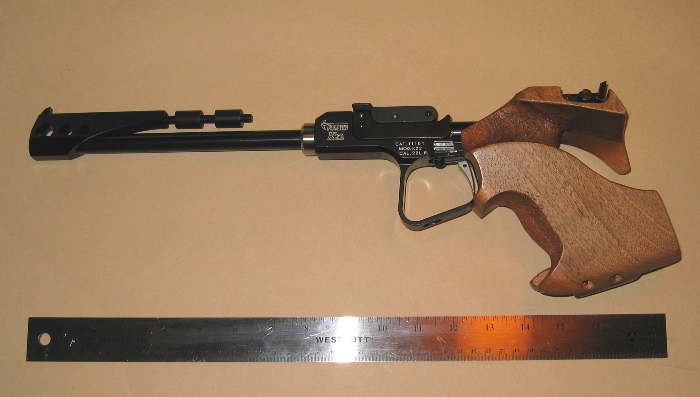
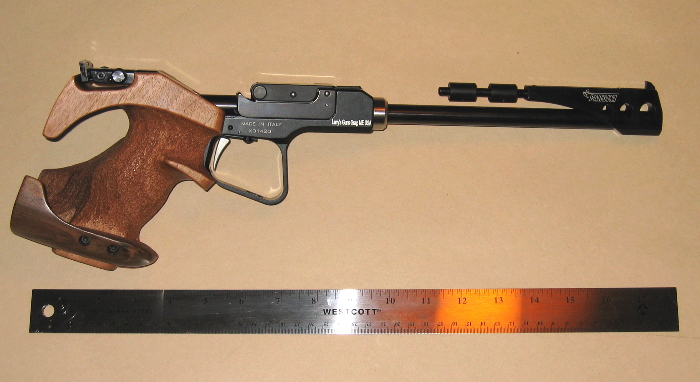
The K22 uses a trigger shoe mounted so it can be rotated on the end of a little rod, which in turn can be slid forward or backward or rotated left or right. (Sorry, I know it's hard to make out the detail in all these small black parts.) The result is that the trigger can be positioned forward or backward and side-to-side and rotated around a vertical axis to it doesn't have to be straight.
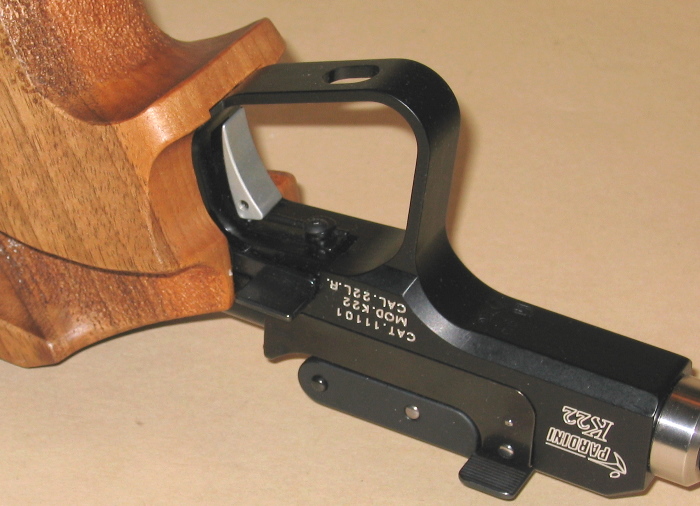
The action uses a sliding bolt, similar to the way the Steyr LP10P works. Lifting the cocking lever slides the bolt back, allowing a round to be chambered, and cocks the hammer. Here are the left and right views of the bolt as it's opened. The lever just above the trigger in the left view is the set lever, which cocks the trigger. The ribbed part just forward of the cocking lever is the bolt slide stop: When it's pushed back, it holds the bolt and the slide in the receiver; pushing it forward allows the bolt and the slide to be removed for cleaning.
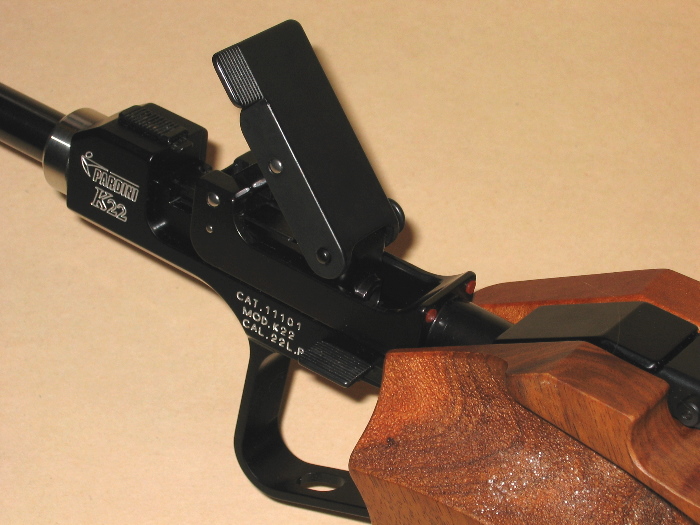
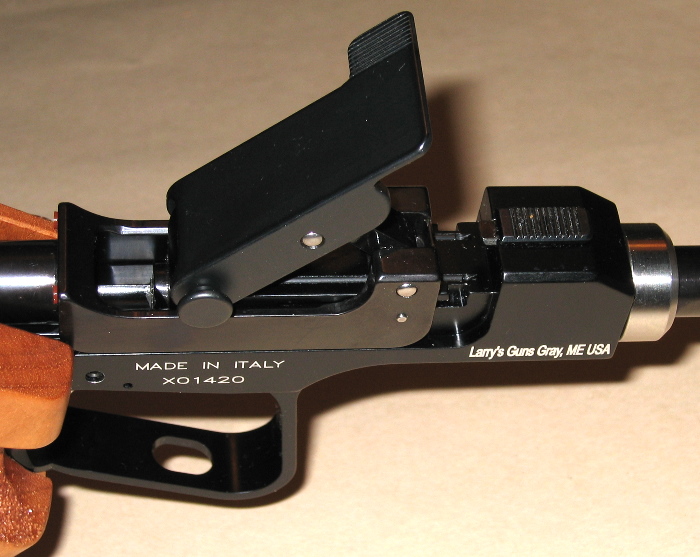
Here you can see a round being chambered, pushed forward by the bolt as it slides forward.
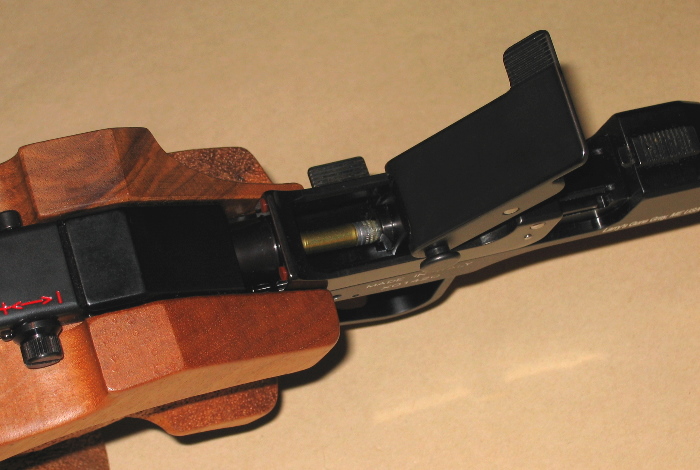
To dry fire the gun, lift the cocking lever to verify the chamber is empty, then close it part way. (The cocking lever will stick up between the sights.) Press the set lever to cock the trigger then pull the trigger. There's a tiny click but no hit to the firing pin. The cocking lever can now be closed completely. At this point, the gun can be dry-fired as many times as desired by repeatedly pressing the set lever, then pulling the trigger.
To remove the bolt for cleaning, a pin is removed from the cocking lever, the bolt slide stop is pushed forward, then the bolt is slid forward and up and out of the gun. This image shows the pin partly removed. All it takes is fingers.
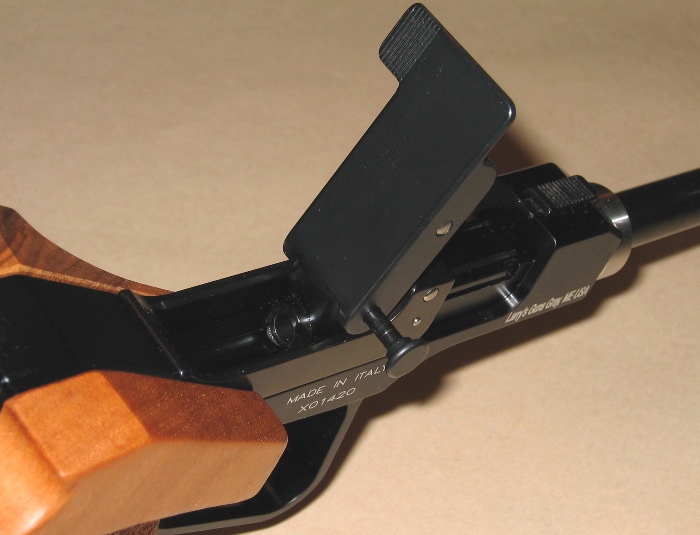
With the pin removed, the slide is freed from the receiver and can then be lifted out.
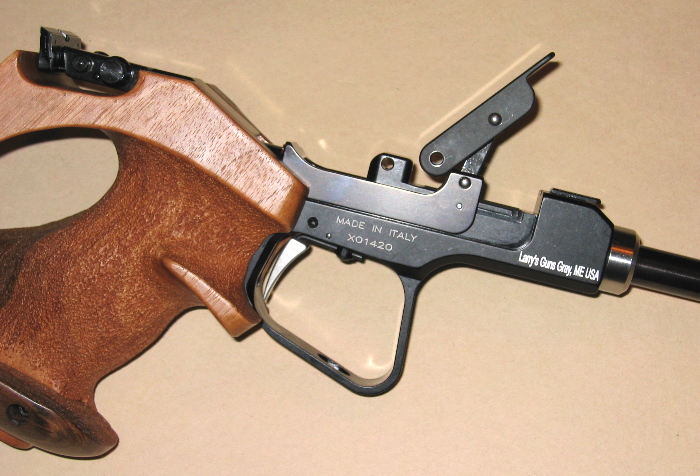
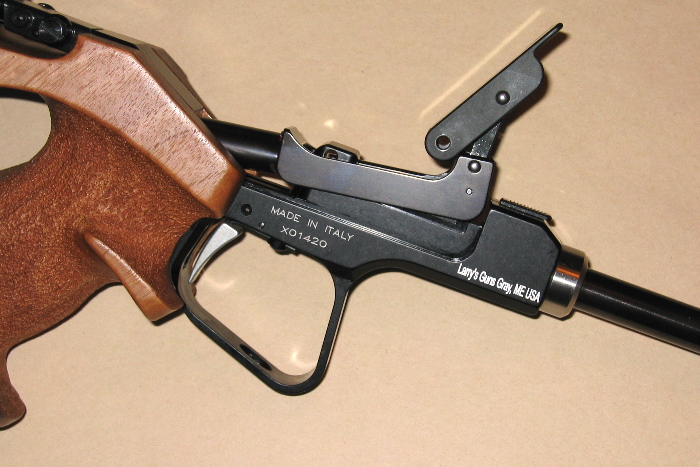
Here are couple views of the gun with the slide and bolt removed.
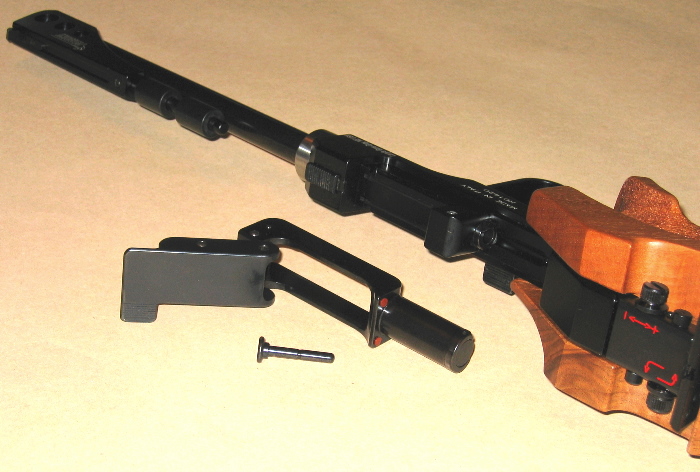
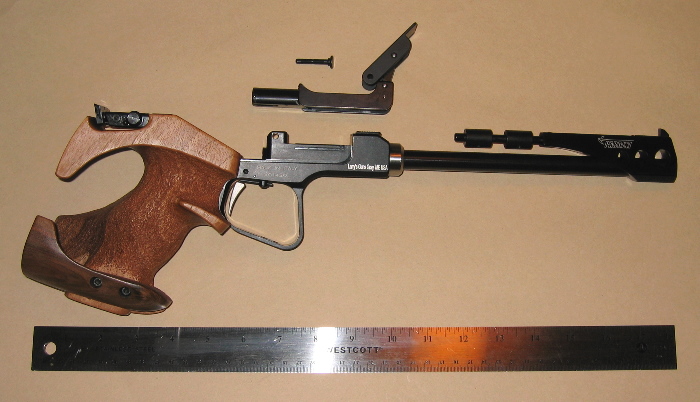
To clean the barrel, a cleaning rod is inserted through a hole in the back of the grip. Given the length of the gun, you need a rifle cleaning rod; an ordinary pistol cleaning rod is too short.
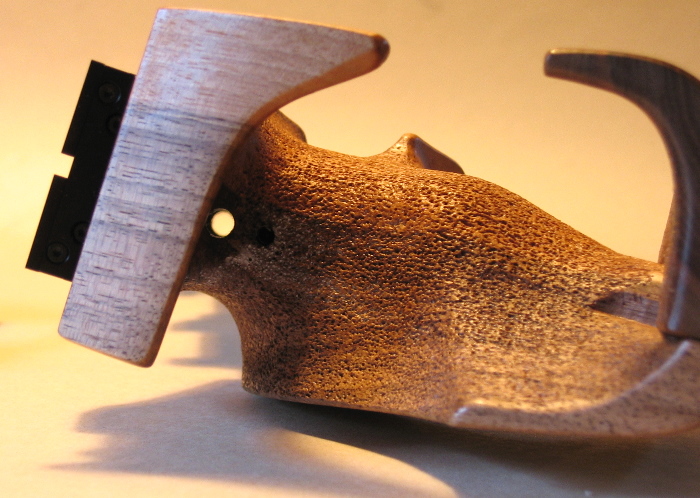
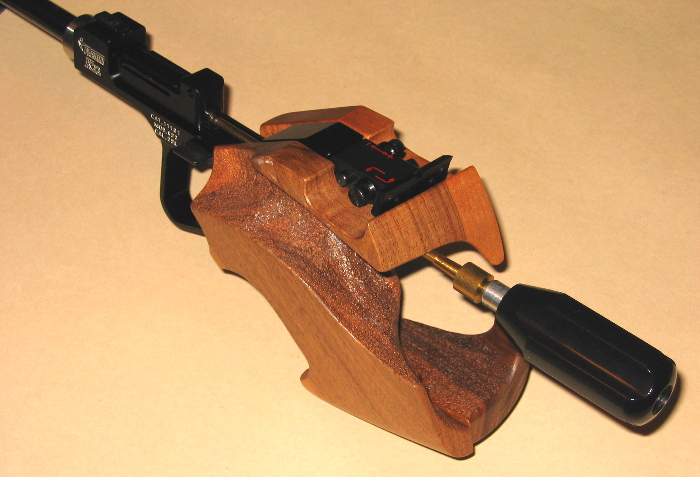
Finally, here's everything you get. The K22 comes in a different style case than the SP or HP. Instead of plastic sliding latches, it has metal latches and a combination lock, kind of like the case the Steyr LP10P comes in, but with waffle foam padding. The case is just barely big enough for the gun. The grip is so big that you do have to push down to get case latched. The long plastic packet contains a cleaning kit; the smaller triangular packet contains various hex and spline wrenches and a narrower front sight.
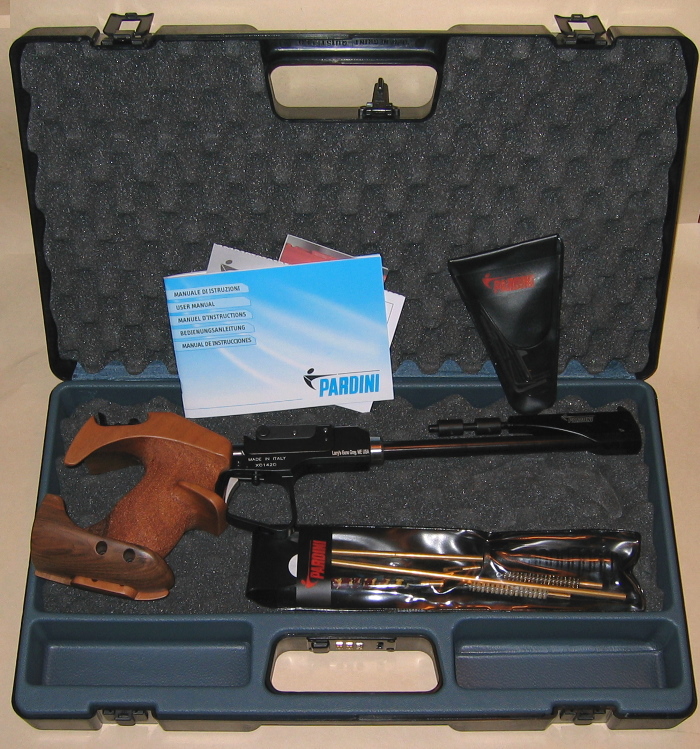
My decision process
It's pretty easy to discover that the two guns most people focus on are the Toz 35 and the Morini 84E, so understandably, these were guns I knew I should consider right from the start. Not many people seemed to like the Pardini. One person told me I'd be "wasting my money" and that it'd have terrible resale value. Here on TT, someone else labeled it "odd-functioning" and "odd-looking." But it didn't appear that anyone making these remarks had actually fired or even handled a K22 and I tend to be pretty independent-minded anyway. Though I don't actually expect resale would be a problem, I decided it wasn't that important to me (I buy guns and I shoot them but I don't sell them :) And oddity, like beauty, is in the eye of the beholder: To me, the K22 certainly didn't look as strange as, say, the Hammerli with "rabbit ears." But mostly, I decided to consider the Pardini K22 because of previous experience with Pardini: I've had two other Pardinis (an SP and an HP) for about 5 years that I've loved and never for a moment regretted buying.
At the club, I was able to try out a couple Toz 35s that belonged to other members. They seemed to point well but I found the triggers too crisp for my taste, especially at the tiny trigger pull weights typical of a free pistol. I like a gun with some tiny amount of takeup so I can safely find the trigger with my finger without accidentally firing the gun. For me, the Toz was hard to control precisely because I wasn't able to do that. Also, I honestly just didn't like the cosmetics of the Toz. What can I say? It's Russian, with all the fit and finish of a lawn mower. For example, though they appeared to work fine, the sights on the one of Tozs were visibly crooked. The other one had come that way, too, apparently, but that the owner told me he had ground it down to get it straight because it had annoyed him, also. Realistically, I'm only an "okay" shooter, hence my adage that if you can't hit the target, at least have a pretty gun. The Toz just wasn't what I wanted.
I really hoped I'd see the Morini 84E and the Pardini K22 "in the flesh" before making a final choice but I was never able to find anyone local who owned either one. But my experience with the Toz trigger did cause me to do some more thinking about what it was I wanted in a trigger. In addition to wanting some takeup, I realized I also really like a traditional design that stops just before it goes off and then clicks under your finger when it does. But the drawings I found online of the Morini trigger made clear that you're just pushing against a spring. There's no sear to make that click. Even though lots of people seem to swear by Morini's electronic trigger, I realized it also just wasn't what I wanted. I wanted a traditional mechanical trigger.
Though I was never able to find anyone locally who owned a K22, I did find a couple K22 owners elsewhere in the country who also owned Pardini SPs. Both volunteered spontaneously that what they liked most about the SP was the trigger and, by gosh, that's what they liked most about the K22. For me, this was compelling.
My initial impressions
The trigger turned out to be exactly as described by the K22 owners. Obviously, there are differences between the SP and the K22: The SP has a 2-stage trigger typically set at 1Kg; the K22 is single-stage and arrives set for a featherweight 50g. But for all the differences, there's also a lot of similarity: Both triggers have some takeup, both are rolling triggers and both go click under your finger when the gun fires. (Takeup, roll and click are just much smaller on the K22.) If you like the trigger in the Pardini SP, my guess you also will really like the trigger in the K22.
The K22 is prettier than most of the pictures online seem to suggest. And apparently, it wasn't just me with that reaction. Several of the fellows I was shooting with Monday also volunteered the same observation. It looked better than they expected. I think that might partly be because the shroud over the muzzle is nicer than expected. In some pictures I'd seen, it looked like it might be just bent sheet metal; it's actually a solid chunk of machined alloy. Everything about the gun seems to ooze quality.
The K22 points unbelievably well. It's like holding your hand out and pointing with your finger. Even though the gun is almost 18" long, there's so little weight in the barrel you don't feel any torque in your hand, twisting it down.
Finally, there's almost no muzzle flip. The recoil (what tiny bit there is) pushes almost straight back into your hand. It feels more like an air pistol than any other cartridge gun I've ever fired.
On the whole, my first experience with the K22 was absolutely delightful and I ended up shooting a 489, a PB, beating out the 488 I had shot once with my SP and the red dot. Considering this was a brand-new gun -- my first chance even to sight it in was in the 15-minute sighter period! -- I went home happy. :)
Photos
One thing that made it hard for me to know what I was getting before I got it was the lack of any decent photos anywhere on the web. It was hard to find out even how the bolt worked. I'm going to try to make up for that here, but capturing detail in a photo when all the parts are the same glossy black is difficult. To see the original high-resolution versions of any of these shots, just click on them. (But be forewarned: The high-res versions are huge!)
Here are the left and right side views of the gun. The grip on this gun is a large. That's an 18" steel ruler next to the gun.


The K22 uses a trigger shoe mounted so it can be rotated on the end of a little rod, which in turn can be slid forward or backward or rotated left or right. (Sorry, I know it's hard to make out the detail in all these small black parts.) The result is that the trigger can be positioned forward or backward and side-to-side and rotated around a vertical axis to it doesn't have to be straight.

The action uses a sliding bolt, similar to the way the Steyr LP10P works. Lifting the cocking lever slides the bolt back, allowing a round to be chambered, and cocks the hammer. Here are the left and right views of the bolt as it's opened. The lever just above the trigger in the left view is the set lever, which cocks the trigger. The ribbed part just forward of the cocking lever is the bolt slide stop: When it's pushed back, it holds the bolt and the slide in the receiver; pushing it forward allows the bolt and the slide to be removed for cleaning.


Here you can see a round being chambered, pushed forward by the bolt as it slides forward.

To dry fire the gun, lift the cocking lever to verify the chamber is empty, then close it part way. (The cocking lever will stick up between the sights.) Press the set lever to cock the trigger then pull the trigger. There's a tiny click but no hit to the firing pin. The cocking lever can now be closed completely. At this point, the gun can be dry-fired as many times as desired by repeatedly pressing the set lever, then pulling the trigger.
To remove the bolt for cleaning, a pin is removed from the cocking lever, the bolt slide stop is pushed forward, then the bolt is slid forward and up and out of the gun. This image shows the pin partly removed. All it takes is fingers.

With the pin removed, the slide is freed from the receiver and can then be lifted out.


Here are couple views of the gun with the slide and bolt removed.


To clean the barrel, a cleaning rod is inserted through a hole in the back of the grip. Given the length of the gun, you need a rifle cleaning rod; an ordinary pistol cleaning rod is too short.


Finally, here's everything you get. The K22 comes in a different style case than the SP or HP. Instead of plastic sliding latches, it has metal latches and a combination lock, kind of like the case the Steyr LP10P comes in, but with waffle foam padding. The case is just barely big enough for the gun. The grip is so big that you do have to push down to get case latched. The long plastic packet contains a cleaning kit; the smaller triangular packet contains various hex and spline wrenches and a narrower front sight.
